Organisational Change: Report on B.R. Richardson Timber Products
VerifiedAdded on 2020/06/05
|12
|3435
|48
Report
AI Summary
This report delves into the realm of organisational change management, specifically focusing on B.R. Richardson Timber Products. The report begins with an introduction to change management and then proceeds to analyze the company's current state, identifying issues such as low employee morale and productivity. It uses Weisbord’s Six-Box Model to diagnose the organisation's functioning. A situational analysis is conducted using PESTLE and McKinsey 7's models to assess external and internal factors impacting the company. The PESTLE analysis examines political, economic, social, technological, legal, and environmental factors, while the McKinsey 7's model explores strategy, structure, systems, shared values, style, staff, and skills. The report highlights the importance of adapting to external factors and aligning internal elements to improve performance. Finally, the report concludes by summarizing the key findings and discussing potential solutions for B.R. Richardson Timber Products to enhance its organisational effectiveness.
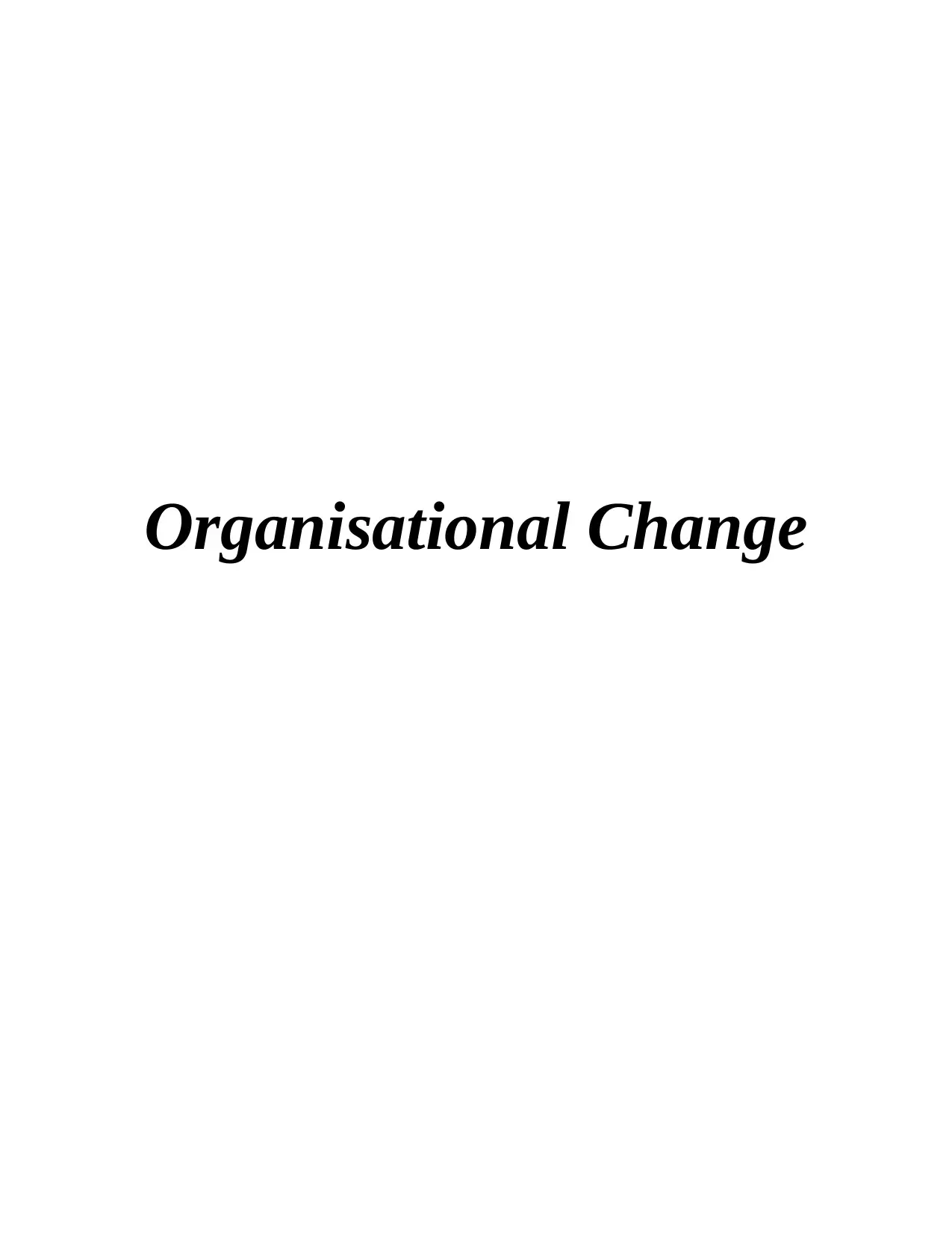
Organisational Change
Paraphrase This Document
Need a fresh take? Get an instant paraphrase of this document with our AI Paraphraser
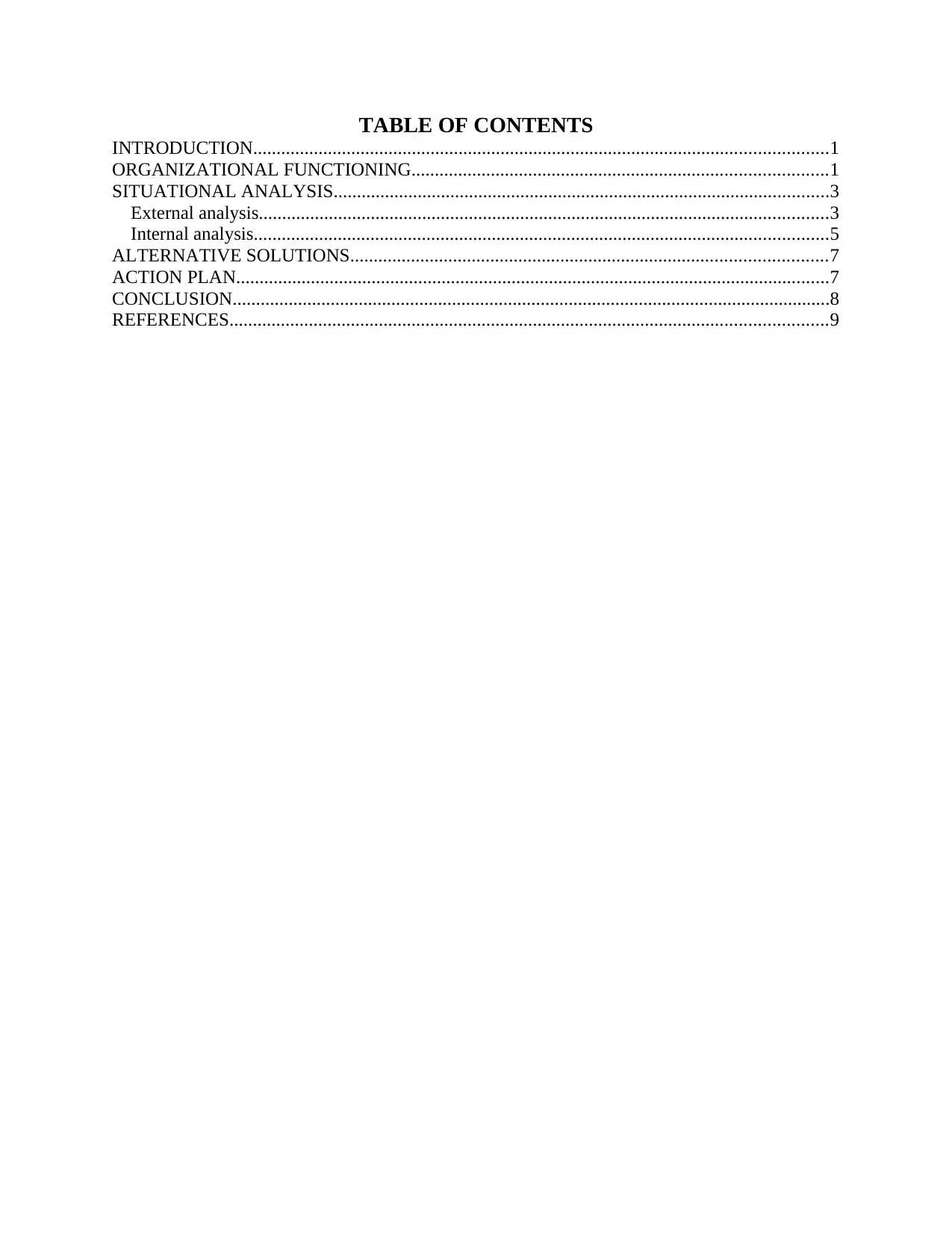
TABLE OF CONTENTS
INTRODUCTION...........................................................................................................................1
ORGANIZATIONAL FUNCTIONING.........................................................................................1
SITUATIONAL ANALYSIS..........................................................................................................3
External analysis..........................................................................................................................3
Internal analysis...........................................................................................................................5
ALTERNATIVE SOLUTIONS......................................................................................................7
ACTION PLAN...............................................................................................................................7
CONCLUSION................................................................................................................................8
REFERENCES................................................................................................................................9
INTRODUCTION...........................................................................................................................1
ORGANIZATIONAL FUNCTIONING.........................................................................................1
SITUATIONAL ANALYSIS..........................................................................................................3
External analysis..........................................................................................................................3
Internal analysis...........................................................................................................................5
ALTERNATIVE SOLUTIONS......................................................................................................7
ACTION PLAN...............................................................................................................................7
CONCLUSION................................................................................................................................8
REFERENCES................................................................................................................................9
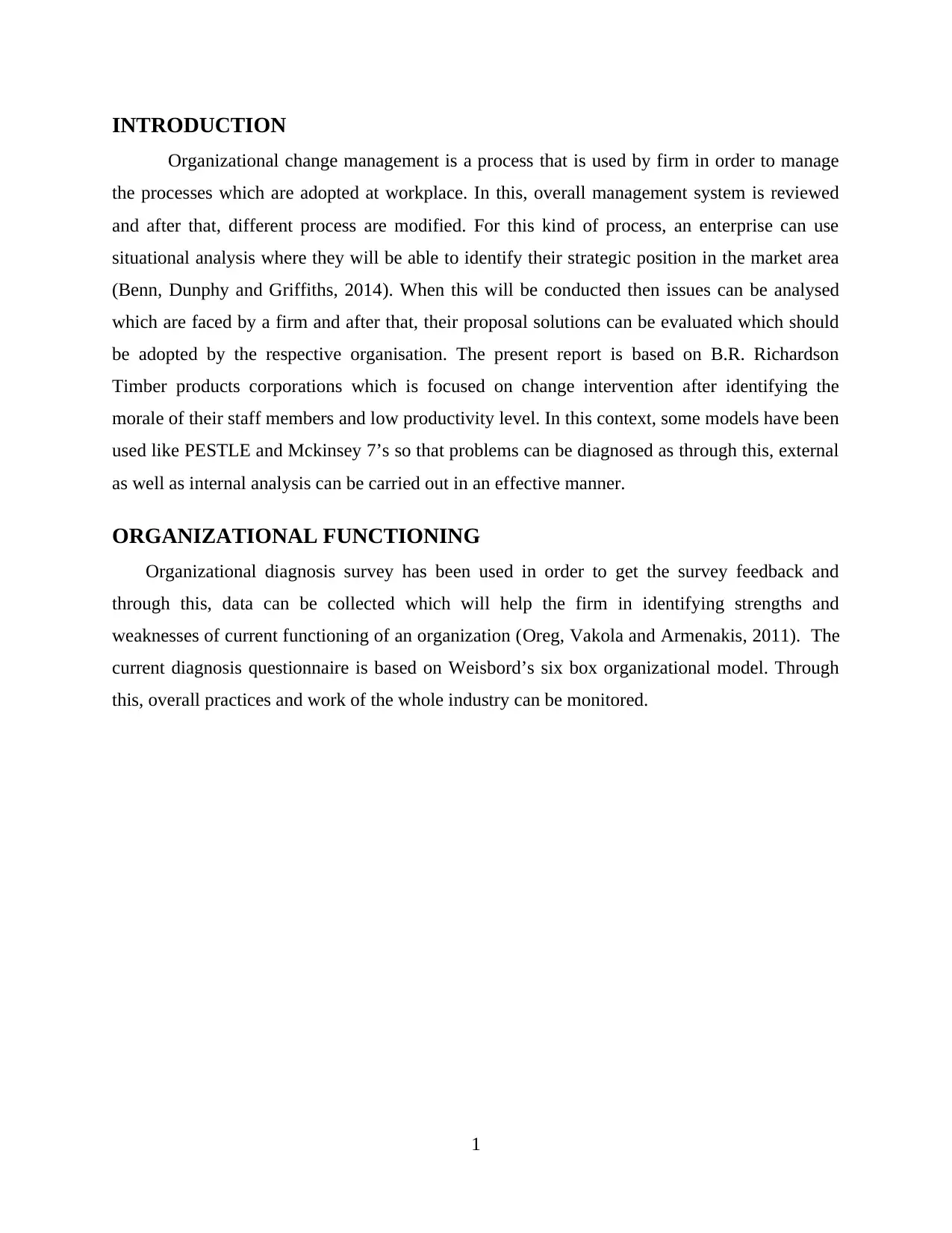
INTRODUCTION
Organizational change management is a process that is used by firm in order to manage
the processes which are adopted at workplace. In this, overall management system is reviewed
and after that, different process are modified. For this kind of process, an enterprise can use
situational analysis where they will be able to identify their strategic position in the market area
(Benn, Dunphy and Griffiths, 2014). When this will be conducted then issues can be analysed
which are faced by a firm and after that, their proposal solutions can be evaluated which should
be adopted by the respective organisation. The present report is based on B.R. Richardson
Timber products corporations which is focused on change intervention after identifying the
morale of their staff members and low productivity level. In this context, some models have been
used like PESTLE and Mckinsey 7’s so that problems can be diagnosed as through this, external
as well as internal analysis can be carried out in an effective manner.
ORGANIZATIONAL FUNCTIONING
Organizational diagnosis survey has been used in order to get the survey feedback and
through this, data can be collected which will help the firm in identifying strengths and
weaknesses of current functioning of an organization (Oreg, Vakola and Armenakis, 2011). The
current diagnosis questionnaire is based on Weisbord’s six box organizational model. Through
this, overall practices and work of the whole industry can be monitored.
1
Organizational change management is a process that is used by firm in order to manage
the processes which are adopted at workplace. In this, overall management system is reviewed
and after that, different process are modified. For this kind of process, an enterprise can use
situational analysis where they will be able to identify their strategic position in the market area
(Benn, Dunphy and Griffiths, 2014). When this will be conducted then issues can be analysed
which are faced by a firm and after that, their proposal solutions can be evaluated which should
be adopted by the respective organisation. The present report is based on B.R. Richardson
Timber products corporations which is focused on change intervention after identifying the
morale of their staff members and low productivity level. In this context, some models have been
used like PESTLE and Mckinsey 7’s so that problems can be diagnosed as through this, external
as well as internal analysis can be carried out in an effective manner.
ORGANIZATIONAL FUNCTIONING
Organizational diagnosis survey has been used in order to get the survey feedback and
through this, data can be collected which will help the firm in identifying strengths and
weaknesses of current functioning of an organization (Oreg, Vakola and Armenakis, 2011). The
current diagnosis questionnaire is based on Weisbord’s six box organizational model. Through
this, overall practices and work of the whole industry can be monitored.
1
⊘ This is a preview!⊘
Do you want full access?
Subscribe today to unlock all pages.

Trusted by 1+ million students worldwide
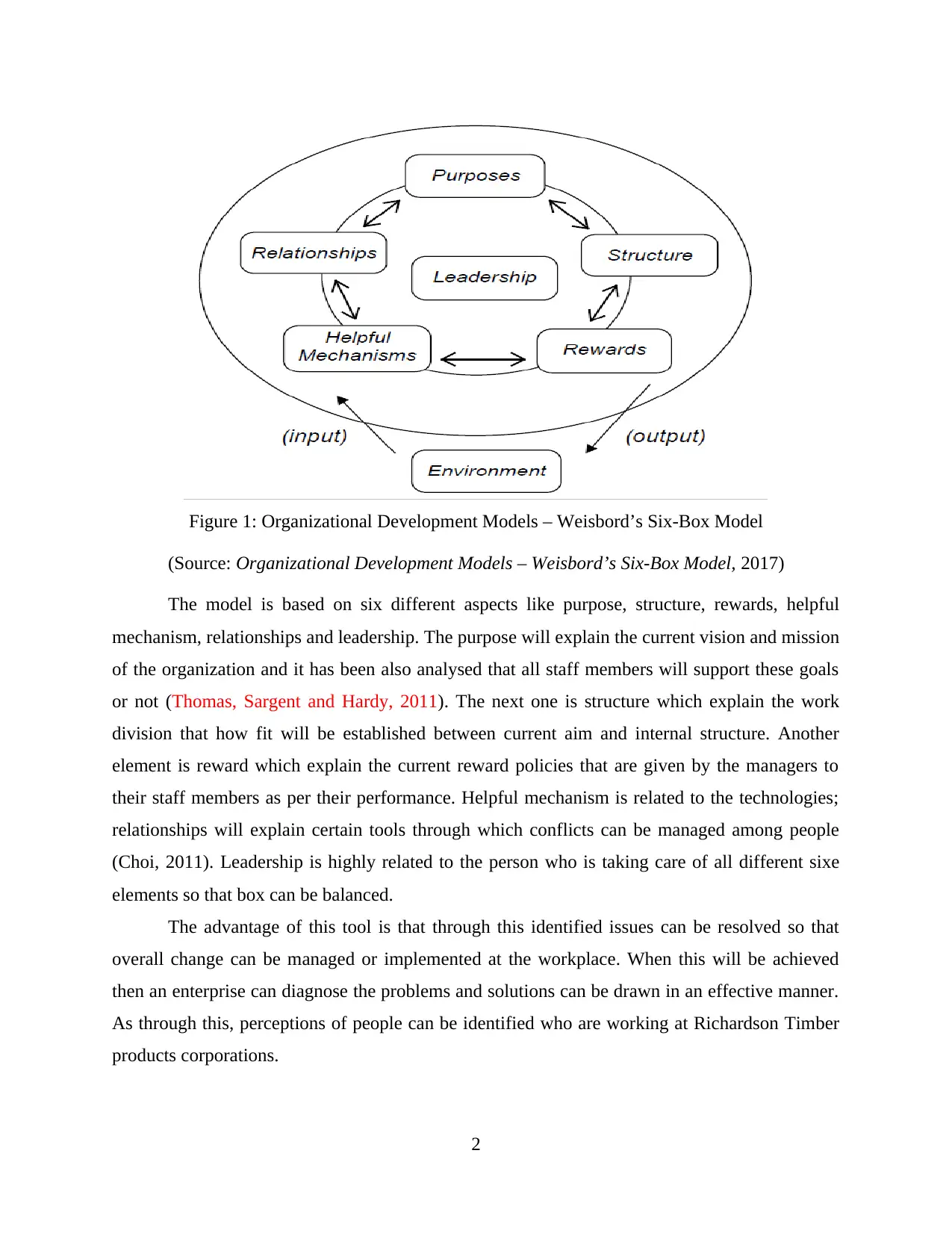
Figure 1: Organizational Development Models – Weisbord’s Six-Box Model
(Source: Organizational Development Models – Weisbord’s Six-Box Model, 2017)
The model is based on six different aspects like purpose, structure, rewards, helpful
mechanism, relationships and leadership. The purpose will explain the current vision and mission
of the organization and it has been also analysed that all staff members will support these goals
or not (Thomas, Sargent and Hardy, 2011). The next one is structure which explain the work
division that how fit will be established between current aim and internal structure. Another
element is reward which explain the current reward policies that are given by the managers to
their staff members as per their performance. Helpful mechanism is related to the technologies;
relationships will explain certain tools through which conflicts can be managed among people
(Choi, 2011). Leadership is highly related to the person who is taking care of all different sixe
elements so that box can be balanced.
The advantage of this tool is that through this identified issues can be resolved so that
overall change can be managed or implemented at the workplace. When this will be achieved
then an enterprise can diagnose the problems and solutions can be drawn in an effective manner.
As through this, perceptions of people can be identified who are working at Richardson Timber
products corporations.
2
(Source: Organizational Development Models – Weisbord’s Six-Box Model, 2017)
The model is based on six different aspects like purpose, structure, rewards, helpful
mechanism, relationships and leadership. The purpose will explain the current vision and mission
of the organization and it has been also analysed that all staff members will support these goals
or not (Thomas, Sargent and Hardy, 2011). The next one is structure which explain the work
division that how fit will be established between current aim and internal structure. Another
element is reward which explain the current reward policies that are given by the managers to
their staff members as per their performance. Helpful mechanism is related to the technologies;
relationships will explain certain tools through which conflicts can be managed among people
(Choi, 2011). Leadership is highly related to the person who is taking care of all different sixe
elements so that box can be balanced.
The advantage of this tool is that through this identified issues can be resolved so that
overall change can be managed or implemented at the workplace. When this will be achieved
then an enterprise can diagnose the problems and solutions can be drawn in an effective manner.
As through this, perceptions of people can be identified who are working at Richardson Timber
products corporations.
2
Paraphrase This Document
Need a fresh take? Get an instant paraphrase of this document with our AI Paraphraser
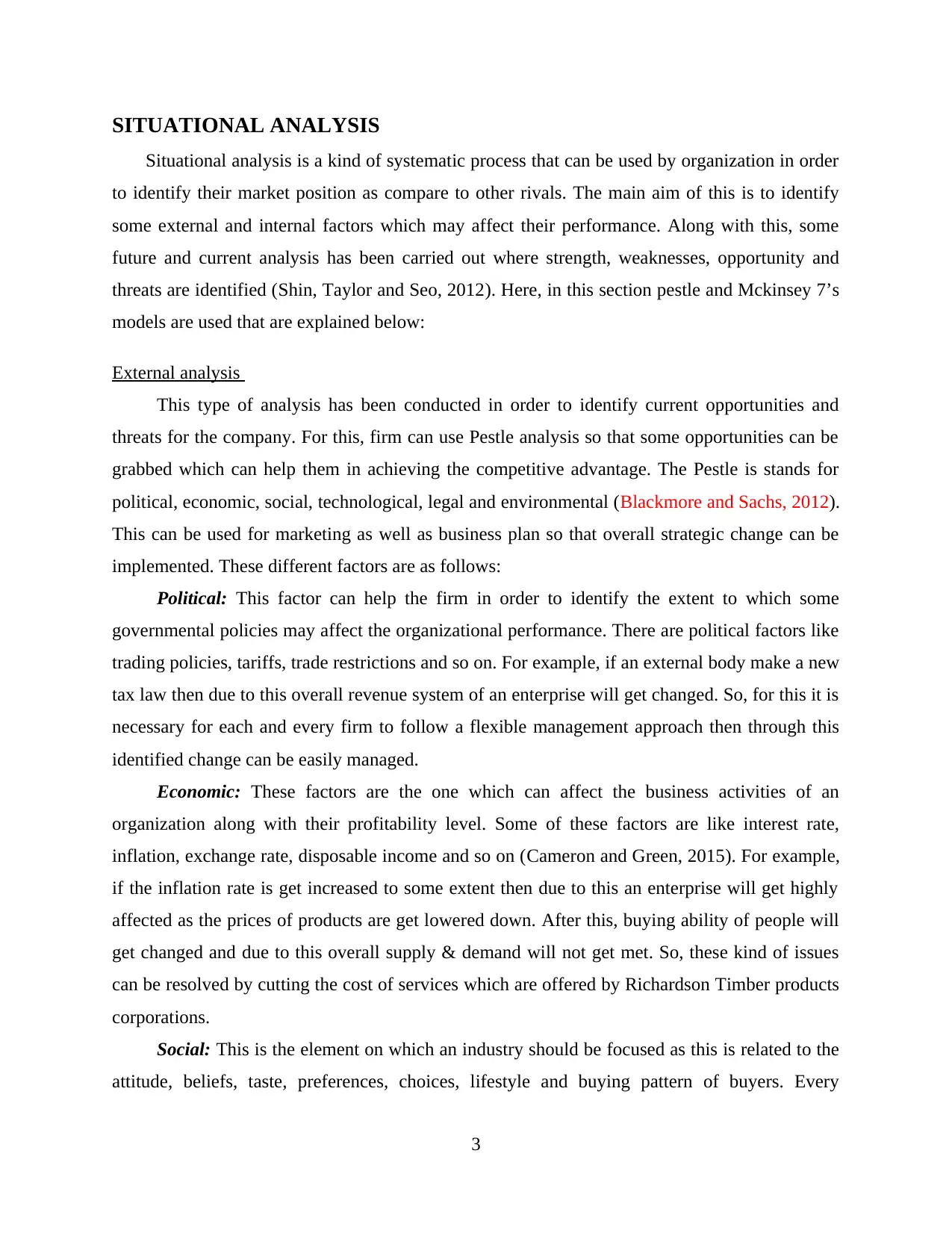
SITUATIONAL ANALYSIS
Situational analysis is a kind of systematic process that can be used by organization in order
to identify their market position as compare to other rivals. The main aim of this is to identify
some external and internal factors which may affect their performance. Along with this, some
future and current analysis has been carried out where strength, weaknesses, opportunity and
threats are identified (Shin, Taylor and Seo, 2012). Here, in this section pestle and Mckinsey 7’s
models are used that are explained below:
External analysis
This type of analysis has been conducted in order to identify current opportunities and
threats for the company. For this, firm can use Pestle analysis so that some opportunities can be
grabbed which can help them in achieving the competitive advantage. The Pestle is stands for
political, economic, social, technological, legal and environmental (Blackmore and Sachs, 2012).
This can be used for marketing as well as business plan so that overall strategic change can be
implemented. These different factors are as follows:
Political: This factor can help the firm in order to identify the extent to which some
governmental policies may affect the organizational performance. There are political factors like
trading policies, tariffs, trade restrictions and so on. For example, if an external body make a new
tax law then due to this overall revenue system of an enterprise will get changed. So, for this it is
necessary for each and every firm to follow a flexible management approach then through this
identified change can be easily managed.
Economic: These factors are the one which can affect the business activities of an
organization along with their profitability level. Some of these factors are like interest rate,
inflation, exchange rate, disposable income and so on (Cameron and Green, 2015). For example,
if the inflation rate is get increased to some extent then due to this an enterprise will get highly
affected as the prices of products are get lowered down. After this, buying ability of people will
get changed and due to this overall supply & demand will not get met. So, these kind of issues
can be resolved by cutting the cost of services which are offered by Richardson Timber products
corporations.
Social: This is the element on which an industry should be focused as this is related to the
attitude, beliefs, taste, preferences, choices, lifestyle and buying pattern of buyers. Every
3
Situational analysis is a kind of systematic process that can be used by organization in order
to identify their market position as compare to other rivals. The main aim of this is to identify
some external and internal factors which may affect their performance. Along with this, some
future and current analysis has been carried out where strength, weaknesses, opportunity and
threats are identified (Shin, Taylor and Seo, 2012). Here, in this section pestle and Mckinsey 7’s
models are used that are explained below:
External analysis
This type of analysis has been conducted in order to identify current opportunities and
threats for the company. For this, firm can use Pestle analysis so that some opportunities can be
grabbed which can help them in achieving the competitive advantage. The Pestle is stands for
political, economic, social, technological, legal and environmental (Blackmore and Sachs, 2012).
This can be used for marketing as well as business plan so that overall strategic change can be
implemented. These different factors are as follows:
Political: This factor can help the firm in order to identify the extent to which some
governmental policies may affect the organizational performance. There are political factors like
trading policies, tariffs, trade restrictions and so on. For example, if an external body make a new
tax law then due to this overall revenue system of an enterprise will get changed. So, for this it is
necessary for each and every firm to follow a flexible management approach then through this
identified change can be easily managed.
Economic: These factors are the one which can affect the business activities of an
organization along with their profitability level. Some of these factors are like interest rate,
inflation, exchange rate, disposable income and so on (Cameron and Green, 2015). For example,
if the inflation rate is get increased to some extent then due to this an enterprise will get highly
affected as the prices of products are get lowered down. After this, buying ability of people will
get changed and due to this overall supply & demand will not get met. So, these kind of issues
can be resolved by cutting the cost of services which are offered by Richardson Timber products
corporations.
Social: This is the element on which an industry should be focused as this is related to the
attitude, beliefs, taste, preferences, choices, lifestyle and buying pattern of buyers. Every
3
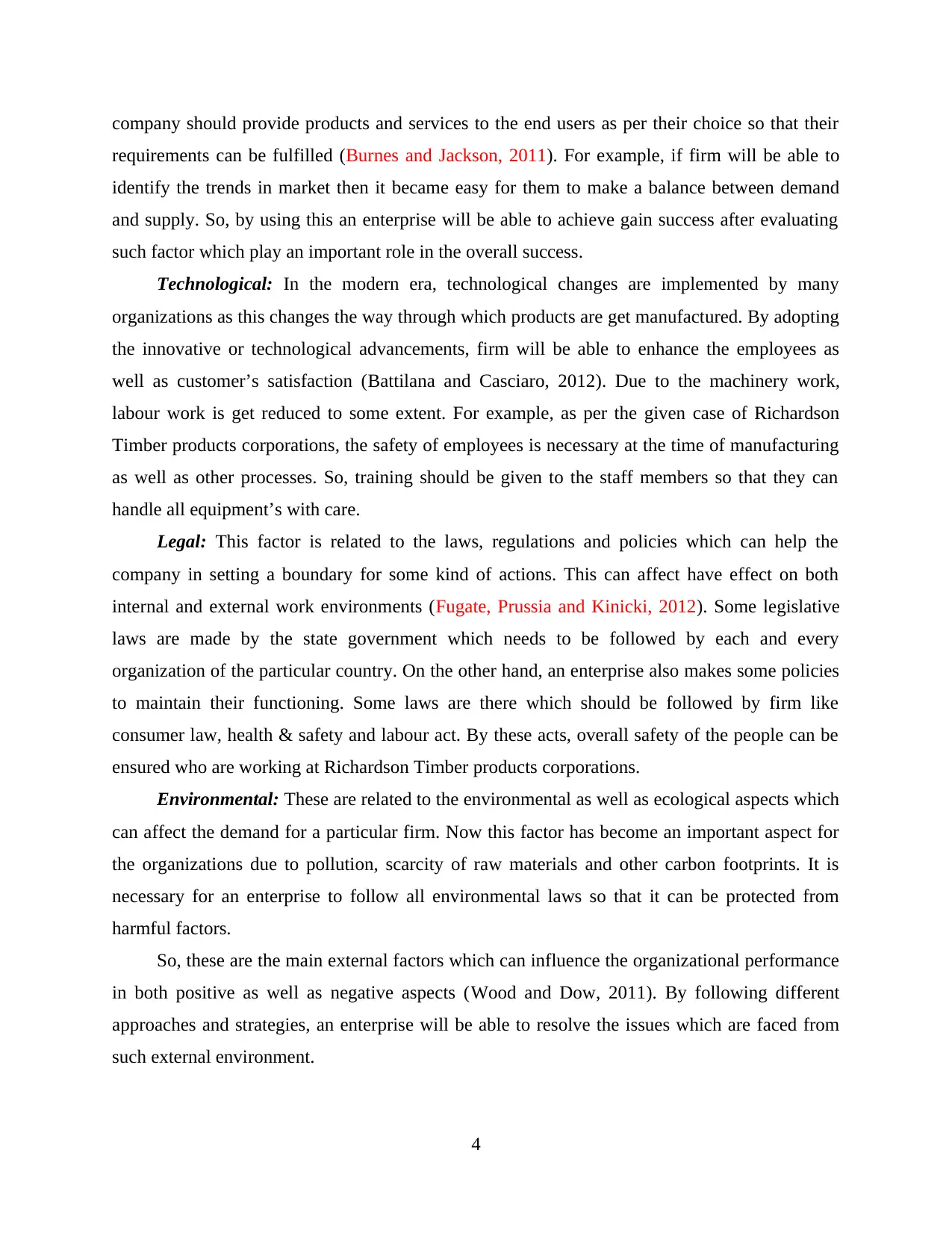
company should provide products and services to the end users as per their choice so that their
requirements can be fulfilled (Burnes and Jackson, 2011). For example, if firm will be able to
identify the trends in market then it became easy for them to make a balance between demand
and supply. So, by using this an enterprise will be able to achieve gain success after evaluating
such factor which play an important role in the overall success.
Technological: In the modern era, technological changes are implemented by many
organizations as this changes the way through which products are get manufactured. By adopting
the innovative or technological advancements, firm will be able to enhance the employees as
well as customer’s satisfaction (Battilana and Casciaro, 2012). Due to the machinery work,
labour work is get reduced to some extent. For example, as per the given case of Richardson
Timber products corporations, the safety of employees is necessary at the time of manufacturing
as well as other processes. So, training should be given to the staff members so that they can
handle all equipment’s with care.
Legal: This factor is related to the laws, regulations and policies which can help the
company in setting a boundary for some kind of actions. This can affect have effect on both
internal and external work environments (Fugate, Prussia and Kinicki, 2012). Some legislative
laws are made by the state government which needs to be followed by each and every
organization of the particular country. On the other hand, an enterprise also makes some policies
to maintain their functioning. Some laws are there which should be followed by firm like
consumer law, health & safety and labour act. By these acts, overall safety of the people can be
ensured who are working at Richardson Timber products corporations.
Environmental: These are related to the environmental as well as ecological aspects which
can affect the demand for a particular firm. Now this factor has become an important aspect for
the organizations due to pollution, scarcity of raw materials and other carbon footprints. It is
necessary for an enterprise to follow all environmental laws so that it can be protected from
harmful factors.
So, these are the main external factors which can influence the organizational performance
in both positive as well as negative aspects (Wood and Dow, 2011). By following different
approaches and strategies, an enterprise will be able to resolve the issues which are faced from
such external environment.
4
requirements can be fulfilled (Burnes and Jackson, 2011). For example, if firm will be able to
identify the trends in market then it became easy for them to make a balance between demand
and supply. So, by using this an enterprise will be able to achieve gain success after evaluating
such factor which play an important role in the overall success.
Technological: In the modern era, technological changes are implemented by many
organizations as this changes the way through which products are get manufactured. By adopting
the innovative or technological advancements, firm will be able to enhance the employees as
well as customer’s satisfaction (Battilana and Casciaro, 2012). Due to the machinery work,
labour work is get reduced to some extent. For example, as per the given case of Richardson
Timber products corporations, the safety of employees is necessary at the time of manufacturing
as well as other processes. So, training should be given to the staff members so that they can
handle all equipment’s with care.
Legal: This factor is related to the laws, regulations and policies which can help the
company in setting a boundary for some kind of actions. This can affect have effect on both
internal and external work environments (Fugate, Prussia and Kinicki, 2012). Some legislative
laws are made by the state government which needs to be followed by each and every
organization of the particular country. On the other hand, an enterprise also makes some policies
to maintain their functioning. Some laws are there which should be followed by firm like
consumer law, health & safety and labour act. By these acts, overall safety of the people can be
ensured who are working at Richardson Timber products corporations.
Environmental: These are related to the environmental as well as ecological aspects which
can affect the demand for a particular firm. Now this factor has become an important aspect for
the organizations due to pollution, scarcity of raw materials and other carbon footprints. It is
necessary for an enterprise to follow all environmental laws so that it can be protected from
harmful factors.
So, these are the main external factors which can influence the organizational performance
in both positive as well as negative aspects (Wood and Dow, 2011). By following different
approaches and strategies, an enterprise will be able to resolve the issues which are faced from
such external environment.
4
⊘ This is a preview!⊘
Do you want full access?
Subscribe today to unlock all pages.

Trusted by 1+ million students worldwide
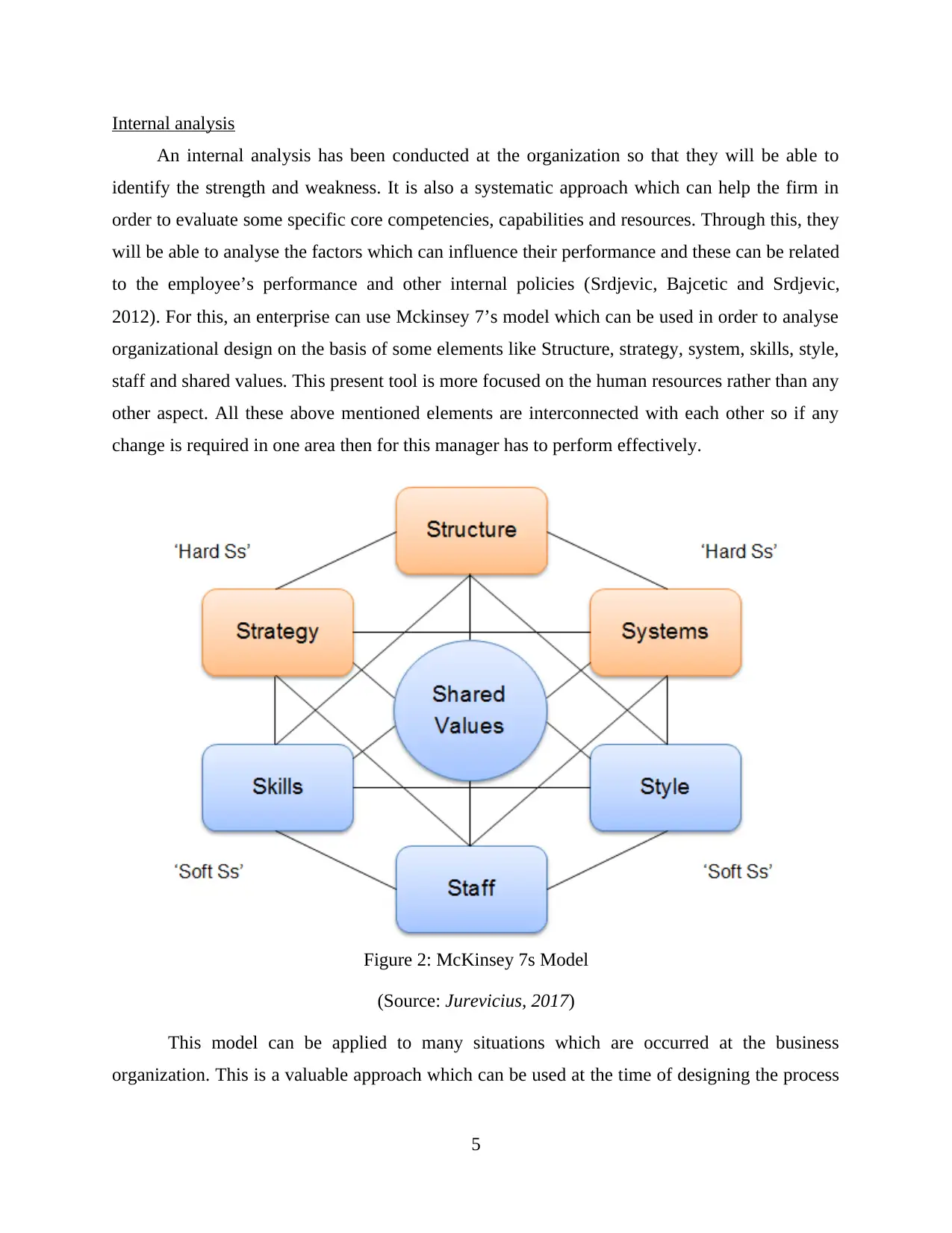
Internal analysis
An internal analysis has been conducted at the organization so that they will be able to
identify the strength and weakness. It is also a systematic approach which can help the firm in
order to evaluate some specific core competencies, capabilities and resources. Through this, they
will be able to analyse the factors which can influence their performance and these can be related
to the employee’s performance and other internal policies (Srdjevic, Bajcetic and Srdjevic,
2012). For this, an enterprise can use Mckinsey 7’s model which can be used in order to analyse
organizational design on the basis of some elements like Structure, strategy, system, skills, style,
staff and shared values. This present tool is more focused on the human resources rather than any
other aspect. All these above mentioned elements are interconnected with each other so if any
change is required in one area then for this manager has to perform effectively.
Figure 2: McKinsey 7s Model
(Source: Jurevicius, 2017)
This model can be applied to many situations which are occurred at the business
organization. This is a valuable approach which can be used at the time of designing the process
5
An internal analysis has been conducted at the organization so that they will be able to
identify the strength and weakness. It is also a systematic approach which can help the firm in
order to evaluate some specific core competencies, capabilities and resources. Through this, they
will be able to analyse the factors which can influence their performance and these can be related
to the employee’s performance and other internal policies (Srdjevic, Bajcetic and Srdjevic,
2012). For this, an enterprise can use Mckinsey 7’s model which can be used in order to analyse
organizational design on the basis of some elements like Structure, strategy, system, skills, style,
staff and shared values. This present tool is more focused on the human resources rather than any
other aspect. All these above mentioned elements are interconnected with each other so if any
change is required in one area then for this manager has to perform effectively.
Figure 2: McKinsey 7s Model
(Source: Jurevicius, 2017)
This model can be applied to many situations which are occurred at the business
organization. This is a valuable approach which can be used at the time of designing the process
5
Paraphrase This Document
Need a fresh take? Get an instant paraphrase of this document with our AI Paraphraser
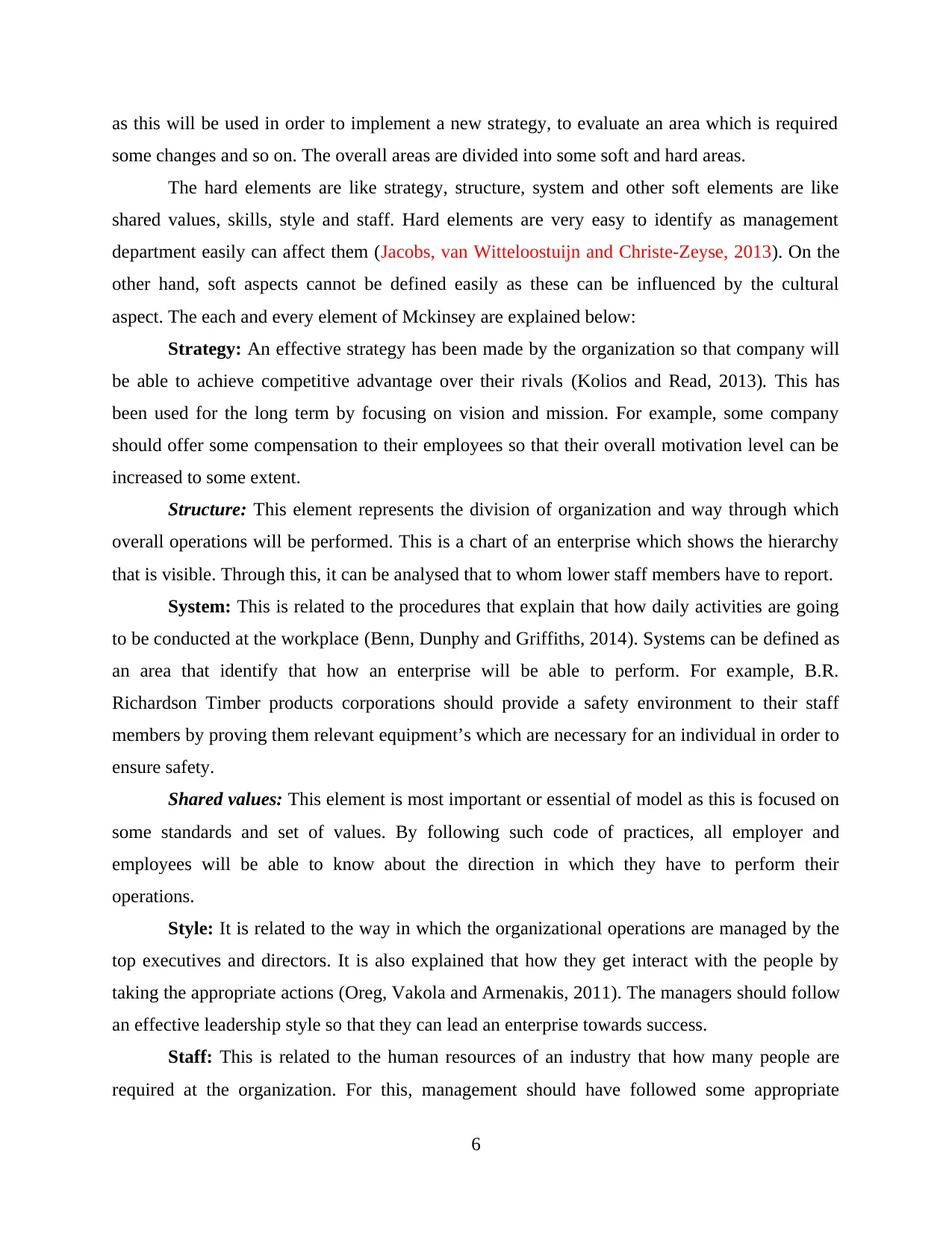
as this will be used in order to implement a new strategy, to evaluate an area which is required
some changes and so on. The overall areas are divided into some soft and hard areas.
The hard elements are like strategy, structure, system and other soft elements are like
shared values, skills, style and staff. Hard elements are very easy to identify as management
department easily can affect them (Jacobs, van Witteloostuijn and Christe-Zeyse, 2013). On the
other hand, soft aspects cannot be defined easily as these can be influenced by the cultural
aspect. The each and every element of Mckinsey are explained below:
Strategy: An effective strategy has been made by the organization so that company will
be able to achieve competitive advantage over their rivals (Kolios and Read, 2013). This has
been used for the long term by focusing on vision and mission. For example, some company
should offer some compensation to their employees so that their overall motivation level can be
increased to some extent.
Structure: This element represents the division of organization and way through which
overall operations will be performed. This is a chart of an enterprise which shows the hierarchy
that is visible. Through this, it can be analysed that to whom lower staff members have to report.
System: This is related to the procedures that explain that how daily activities are going
to be conducted at the workplace (Benn, Dunphy and Griffiths, 2014). Systems can be defined as
an area that identify that how an enterprise will be able to perform. For example, B.R.
Richardson Timber products corporations should provide a safety environment to their staff
members by proving them relevant equipment’s which are necessary for an individual in order to
ensure safety.
Shared values: This element is most important or essential of model as this is focused on
some standards and set of values. By following such code of practices, all employer and
employees will be able to know about the direction in which they have to perform their
operations.
Style: It is related to the way in which the organizational operations are managed by the
top executives and directors. It is also explained that how they get interact with the people by
taking the appropriate actions (Oreg, Vakola and Armenakis, 2011). The managers should follow
an effective leadership style so that they can lead an enterprise towards success.
Staff: This is related to the human resources of an industry that how many people are
required at the organization. For this, management should have followed some appropriate
6
some changes and so on. The overall areas are divided into some soft and hard areas.
The hard elements are like strategy, structure, system and other soft elements are like
shared values, skills, style and staff. Hard elements are very easy to identify as management
department easily can affect them (Jacobs, van Witteloostuijn and Christe-Zeyse, 2013). On the
other hand, soft aspects cannot be defined easily as these can be influenced by the cultural
aspect. The each and every element of Mckinsey are explained below:
Strategy: An effective strategy has been made by the organization so that company will
be able to achieve competitive advantage over their rivals (Kolios and Read, 2013). This has
been used for the long term by focusing on vision and mission. For example, some company
should offer some compensation to their employees so that their overall motivation level can be
increased to some extent.
Structure: This element represents the division of organization and way through which
overall operations will be performed. This is a chart of an enterprise which shows the hierarchy
that is visible. Through this, it can be analysed that to whom lower staff members have to report.
System: This is related to the procedures that explain that how daily activities are going
to be conducted at the workplace (Benn, Dunphy and Griffiths, 2014). Systems can be defined as
an area that identify that how an enterprise will be able to perform. For example, B.R.
Richardson Timber products corporations should provide a safety environment to their staff
members by proving them relevant equipment’s which are necessary for an individual in order to
ensure safety.
Shared values: This element is most important or essential of model as this is focused on
some standards and set of values. By following such code of practices, all employer and
employees will be able to know about the direction in which they have to perform their
operations.
Style: It is related to the way in which the organizational operations are managed by the
top executives and directors. It is also explained that how they get interact with the people by
taking the appropriate actions (Oreg, Vakola and Armenakis, 2011). The managers should follow
an effective leadership style so that they can lead an enterprise towards success.
Staff: This is related to the human resources of an industry that how many people are
required at the organization. For this, management should have followed some appropriate
6
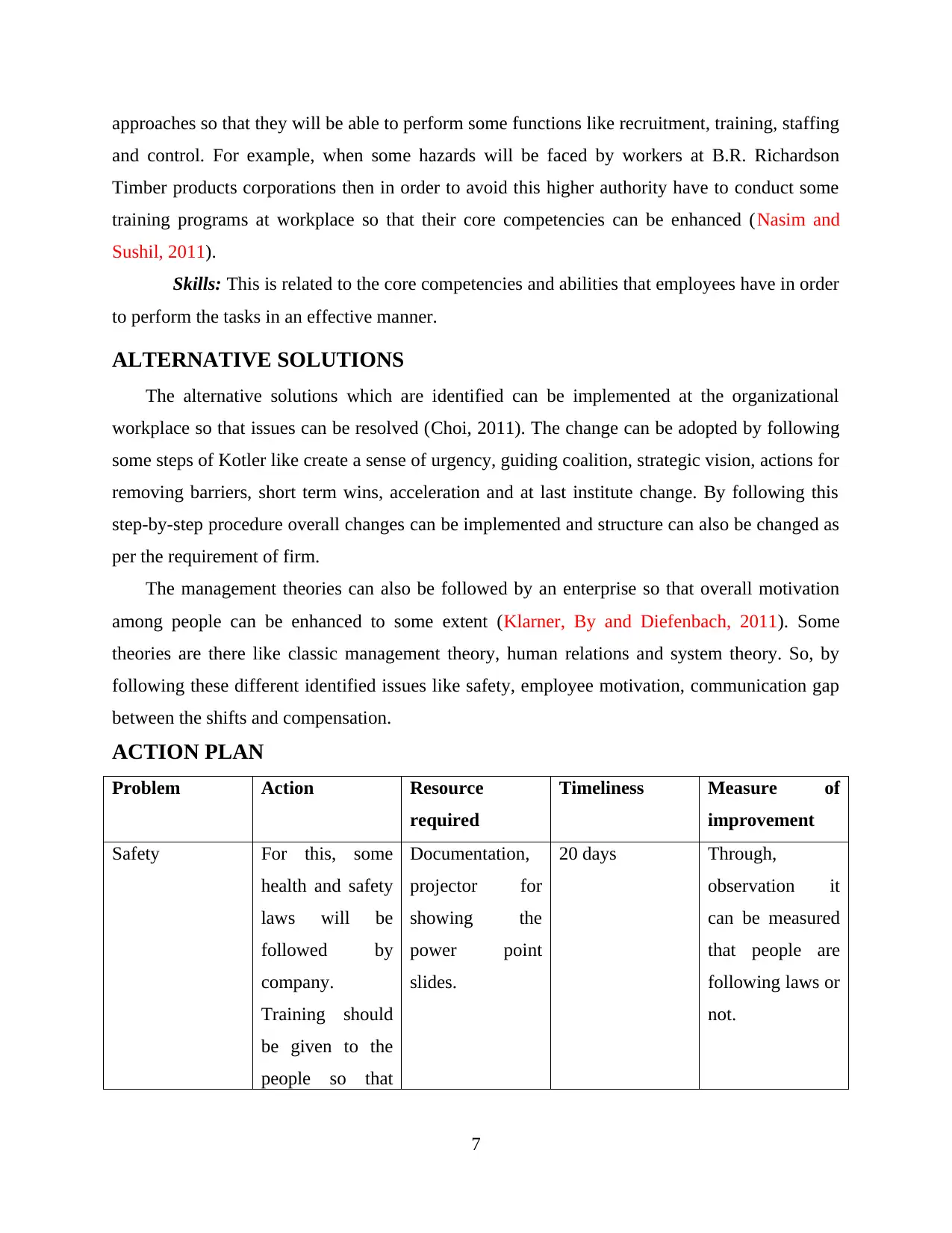
approaches so that they will be able to perform some functions like recruitment, training, staffing
and control. For example, when some hazards will be faced by workers at B.R. Richardson
Timber products corporations then in order to avoid this higher authority have to conduct some
training programs at workplace so that their core competencies can be enhanced (Nasim and
Sushil, 2011).
Skills: This is related to the core competencies and abilities that employees have in order
to perform the tasks in an effective manner.
ALTERNATIVE SOLUTIONS
The alternative solutions which are identified can be implemented at the organizational
workplace so that issues can be resolved (Choi, 2011). The change can be adopted by following
some steps of Kotler like create a sense of urgency, guiding coalition, strategic vision, actions for
removing barriers, short term wins, acceleration and at last institute change. By following this
step-by-step procedure overall changes can be implemented and structure can also be changed as
per the requirement of firm.
The management theories can also be followed by an enterprise so that overall motivation
among people can be enhanced to some extent (Klarner, By and Diefenbach, 2011). Some
theories are there like classic management theory, human relations and system theory. So, by
following these different identified issues like safety, employee motivation, communication gap
between the shifts and compensation.
ACTION PLAN
Problem Action Resource
required
Timeliness Measure of
improvement
Safety For this, some
health and safety
laws will be
followed by
company.
Training should
be given to the
people so that
Documentation,
projector for
showing the
power point
slides.
20 days Through,
observation it
can be measured
that people are
following laws or
not.
7
and control. For example, when some hazards will be faced by workers at B.R. Richardson
Timber products corporations then in order to avoid this higher authority have to conduct some
training programs at workplace so that their core competencies can be enhanced (Nasim and
Sushil, 2011).
Skills: This is related to the core competencies and abilities that employees have in order
to perform the tasks in an effective manner.
ALTERNATIVE SOLUTIONS
The alternative solutions which are identified can be implemented at the organizational
workplace so that issues can be resolved (Choi, 2011). The change can be adopted by following
some steps of Kotler like create a sense of urgency, guiding coalition, strategic vision, actions for
removing barriers, short term wins, acceleration and at last institute change. By following this
step-by-step procedure overall changes can be implemented and structure can also be changed as
per the requirement of firm.
The management theories can also be followed by an enterprise so that overall motivation
among people can be enhanced to some extent (Klarner, By and Diefenbach, 2011). Some
theories are there like classic management theory, human relations and system theory. So, by
following these different identified issues like safety, employee motivation, communication gap
between the shifts and compensation.
ACTION PLAN
Problem Action Resource
required
Timeliness Measure of
improvement
Safety For this, some
health and safety
laws will be
followed by
company.
Training should
be given to the
people so that
Documentation,
projector for
showing the
power point
slides.
20 days Through,
observation it
can be measured
that people are
following laws or
not.
7
⊘ This is a preview!⊘
Do you want full access?
Subscribe today to unlock all pages.

Trusted by 1+ million students worldwide
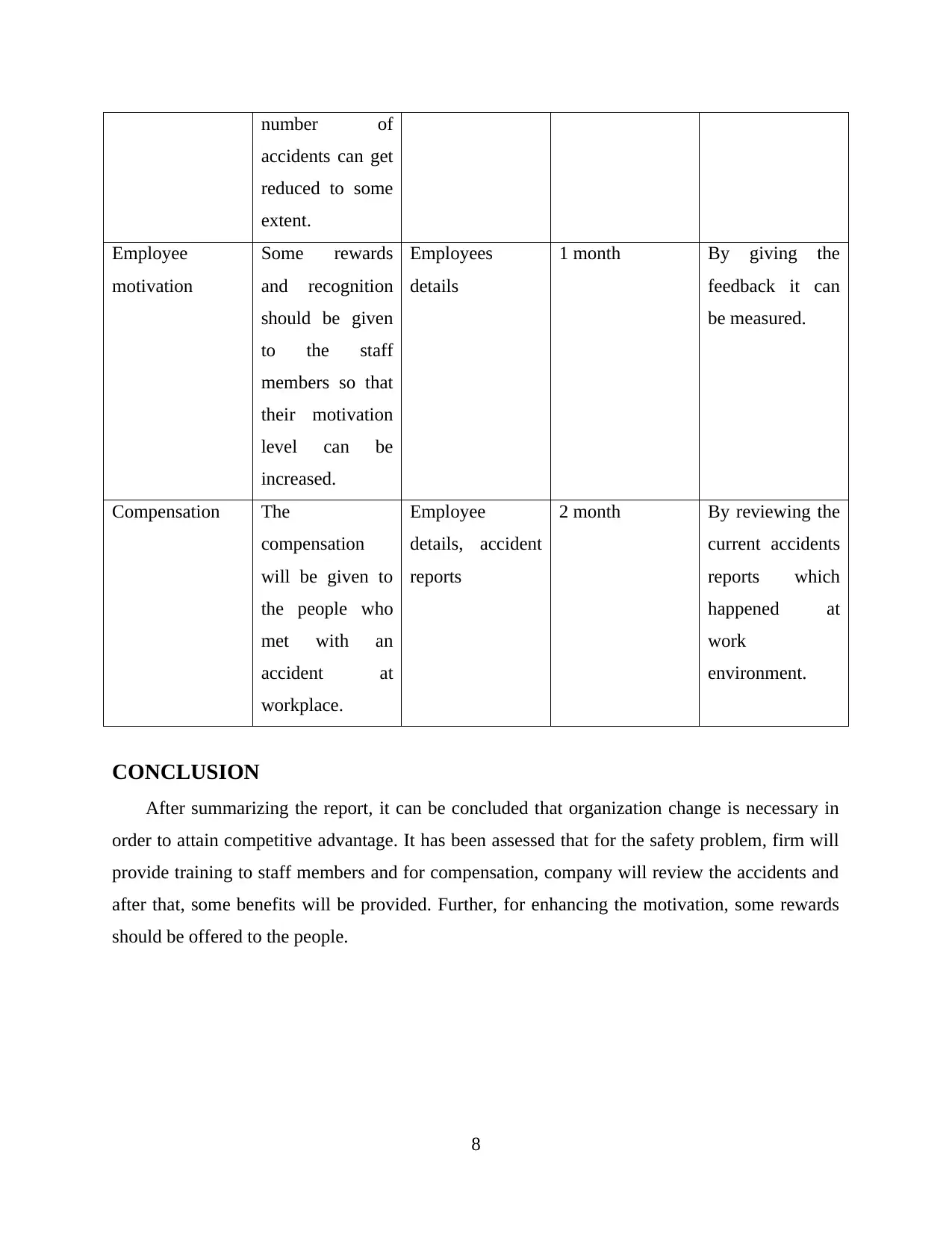
number of
accidents can get
reduced to some
extent.
Employee
motivation
Some rewards
and recognition
should be given
to the staff
members so that
their motivation
level can be
increased.
Employees
details
1 month By giving the
feedback it can
be measured.
Compensation The
compensation
will be given to
the people who
met with an
accident at
workplace.
Employee
details, accident
reports
2 month By reviewing the
current accidents
reports which
happened at
work
environment.
CONCLUSION
After summarizing the report, it can be concluded that organization change is necessary in
order to attain competitive advantage. It has been assessed that for the safety problem, firm will
provide training to staff members and for compensation, company will review the accidents and
after that, some benefits will be provided. Further, for enhancing the motivation, some rewards
should be offered to the people.
8
accidents can get
reduced to some
extent.
Employee
motivation
Some rewards
and recognition
should be given
to the staff
members so that
their motivation
level can be
increased.
Employees
details
1 month By giving the
feedback it can
be measured.
Compensation The
compensation
will be given to
the people who
met with an
accident at
workplace.
Employee
details, accident
reports
2 month By reviewing the
current accidents
reports which
happened at
work
environment.
CONCLUSION
After summarizing the report, it can be concluded that organization change is necessary in
order to attain competitive advantage. It has been assessed that for the safety problem, firm will
provide training to staff members and for compensation, company will review the accidents and
after that, some benefits will be provided. Further, for enhancing the motivation, some rewards
should be offered to the people.
8
Paraphrase This Document
Need a fresh take? Get an instant paraphrase of this document with our AI Paraphraser
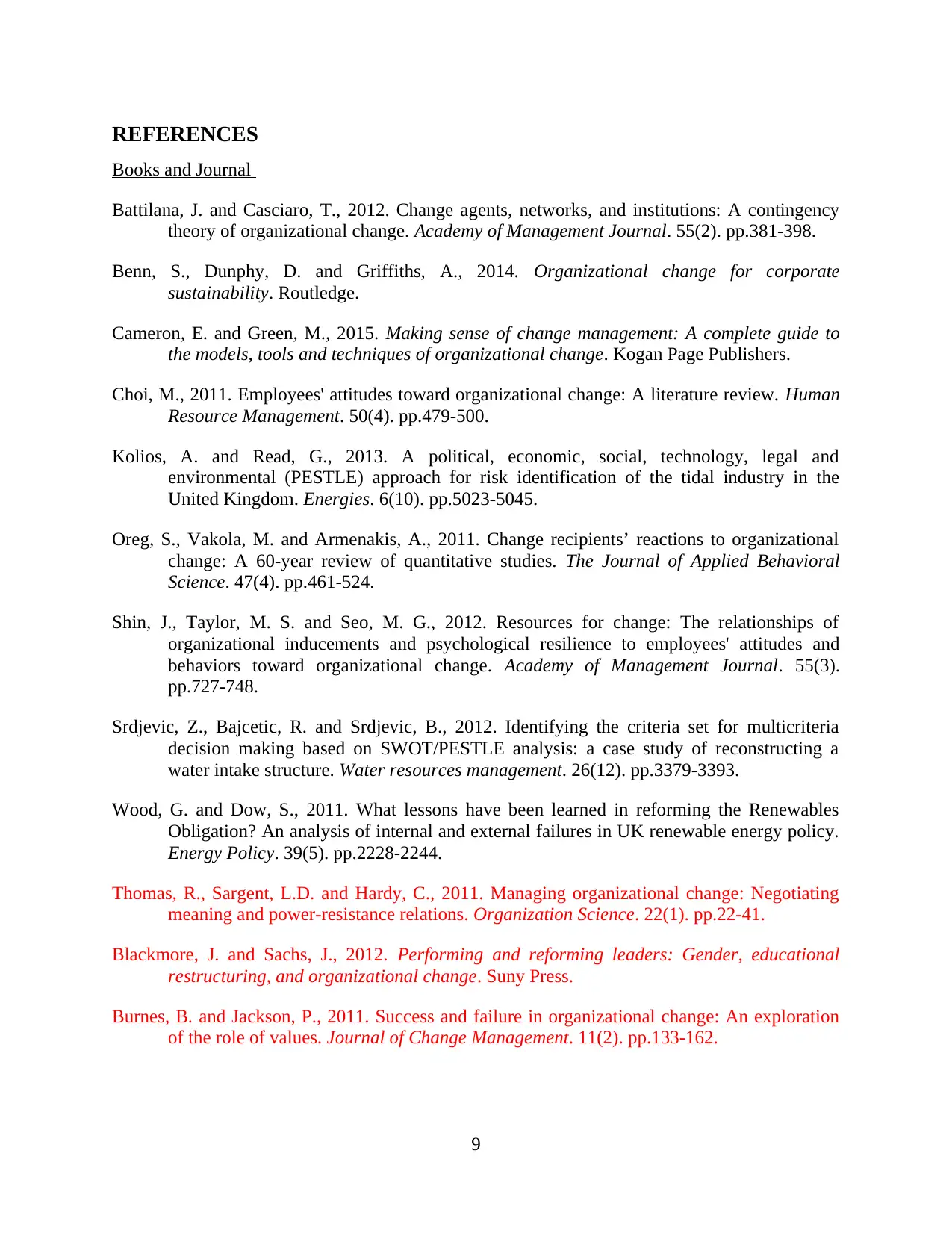
REFERENCES
Books and Journal
Battilana, J. and Casciaro, T., 2012. Change agents, networks, and institutions: A contingency
theory of organizational change. Academy of Management Journal. 55(2). pp.381-398.
Benn, S., Dunphy, D. and Griffiths, A., 2014. Organizational change for corporate
sustainability. Routledge.
Cameron, E. and Green, M., 2015. Making sense of change management: A complete guide to
the models, tools and techniques of organizational change. Kogan Page Publishers.
Choi, M., 2011. Employees' attitudes toward organizational change: A literature review. Human
Resource Management. 50(4). pp.479-500.
Kolios, A. and Read, G., 2013. A political, economic, social, technology, legal and
environmental (PESTLE) approach for risk identification of the tidal industry in the
United Kingdom. Energies. 6(10). pp.5023-5045.
Oreg, S., Vakola, M. and Armenakis, A., 2011. Change recipients’ reactions to organizational
change: A 60-year review of quantitative studies. The Journal of Applied Behavioral
Science. 47(4). pp.461-524.
Shin, J., Taylor, M. S. and Seo, M. G., 2012. Resources for change: The relationships of
organizational inducements and psychological resilience to employees' attitudes and
behaviors toward organizational change. Academy of Management Journal. 55(3).
pp.727-748.
Srdjevic, Z., Bajcetic, R. and Srdjevic, B., 2012. Identifying the criteria set for multicriteria
decision making based on SWOT/PESTLE analysis: a case study of reconstructing a
water intake structure. Water resources management. 26(12). pp.3379-3393.
Wood, G. and Dow, S., 2011. What lessons have been learned in reforming the Renewables
Obligation? An analysis of internal and external failures in UK renewable energy policy.
Energy Policy. 39(5). pp.2228-2244.
Thomas, R., Sargent, L.D. and Hardy, C., 2011. Managing organizational change: Negotiating
meaning and power-resistance relations. Organization Science. 22(1). pp.22-41.
Blackmore, J. and Sachs, J., 2012. Performing and reforming leaders: Gender, educational
restructuring, and organizational change. Suny Press.
Burnes, B. and Jackson, P., 2011. Success and failure in organizational change: An exploration
of the role of values. Journal of Change Management. 11(2). pp.133-162.
9
Books and Journal
Battilana, J. and Casciaro, T., 2012. Change agents, networks, and institutions: A contingency
theory of organizational change. Academy of Management Journal. 55(2). pp.381-398.
Benn, S., Dunphy, D. and Griffiths, A., 2014. Organizational change for corporate
sustainability. Routledge.
Cameron, E. and Green, M., 2015. Making sense of change management: A complete guide to
the models, tools and techniques of organizational change. Kogan Page Publishers.
Choi, M., 2011. Employees' attitudes toward organizational change: A literature review. Human
Resource Management. 50(4). pp.479-500.
Kolios, A. and Read, G., 2013. A political, economic, social, technology, legal and
environmental (PESTLE) approach for risk identification of the tidal industry in the
United Kingdom. Energies. 6(10). pp.5023-5045.
Oreg, S., Vakola, M. and Armenakis, A., 2011. Change recipients’ reactions to organizational
change: A 60-year review of quantitative studies. The Journal of Applied Behavioral
Science. 47(4). pp.461-524.
Shin, J., Taylor, M. S. and Seo, M. G., 2012. Resources for change: The relationships of
organizational inducements and psychological resilience to employees' attitudes and
behaviors toward organizational change. Academy of Management Journal. 55(3).
pp.727-748.
Srdjevic, Z., Bajcetic, R. and Srdjevic, B., 2012. Identifying the criteria set for multicriteria
decision making based on SWOT/PESTLE analysis: a case study of reconstructing a
water intake structure. Water resources management. 26(12). pp.3379-3393.
Wood, G. and Dow, S., 2011. What lessons have been learned in reforming the Renewables
Obligation? An analysis of internal and external failures in UK renewable energy policy.
Energy Policy. 39(5). pp.2228-2244.
Thomas, R., Sargent, L.D. and Hardy, C., 2011. Managing organizational change: Negotiating
meaning and power-resistance relations. Organization Science. 22(1). pp.22-41.
Blackmore, J. and Sachs, J., 2012. Performing and reforming leaders: Gender, educational
restructuring, and organizational change. Suny Press.
Burnes, B. and Jackson, P., 2011. Success and failure in organizational change: An exploration
of the role of values. Journal of Change Management. 11(2). pp.133-162.
9
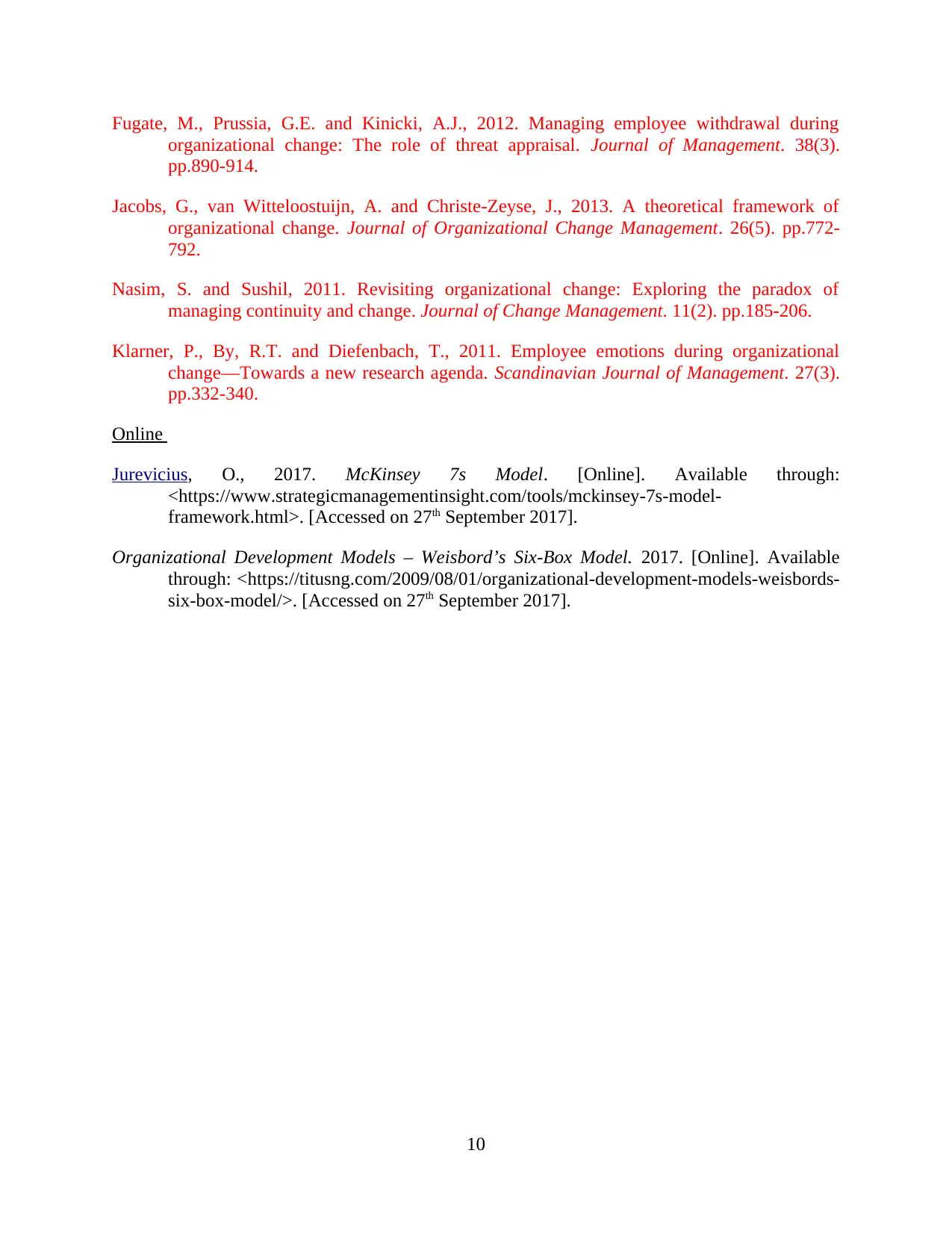
Fugate, M., Prussia, G.E. and Kinicki, A.J., 2012. Managing employee withdrawal during
organizational change: The role of threat appraisal. Journal of Management. 38(3).
pp.890-914.
Jacobs, G., van Witteloostuijn, A. and Christe-Zeyse, J., 2013. A theoretical framework of
organizational change. Journal of Organizational Change Management. 26(5). pp.772-
792.
Nasim, S. and Sushil, 2011. Revisiting organizational change: Exploring the paradox of
managing continuity and change. Journal of Change Management. 11(2). pp.185-206.
Klarner, P., By, R.T. and Diefenbach, T., 2011. Employee emotions during organizational
change—Towards a new research agenda. Scandinavian Journal of Management. 27(3).
pp.332-340.
Online
Jurevicius, O., 2017. McKinsey 7s Model. [Online]. Available through:
<https://www.strategicmanagementinsight.com/tools/mckinsey-7s-model-
framework.html>. [Accessed on 27th September 2017].
Organizational Development Models – Weisbord’s Six-Box Model. 2017. [Online]. Available
through: <https://titusng.com/2009/08/01/organizational-development-models-weisbords-
six-box-model/>. [Accessed on 27th September 2017].
10
organizational change: The role of threat appraisal. Journal of Management. 38(3).
pp.890-914.
Jacobs, G., van Witteloostuijn, A. and Christe-Zeyse, J., 2013. A theoretical framework of
organizational change. Journal of Organizational Change Management. 26(5). pp.772-
792.
Nasim, S. and Sushil, 2011. Revisiting organizational change: Exploring the paradox of
managing continuity and change. Journal of Change Management. 11(2). pp.185-206.
Klarner, P., By, R.T. and Diefenbach, T., 2011. Employee emotions during organizational
change—Towards a new research agenda. Scandinavian Journal of Management. 27(3).
pp.332-340.
Online
Jurevicius, O., 2017. McKinsey 7s Model. [Online]. Available through:
<https://www.strategicmanagementinsight.com/tools/mckinsey-7s-model-
framework.html>. [Accessed on 27th September 2017].
Organizational Development Models – Weisbord’s Six-Box Model. 2017. [Online]. Available
through: <https://titusng.com/2009/08/01/organizational-development-models-weisbords-
six-box-model/>. [Accessed on 27th September 2017].
10
⊘ This is a preview!⊘
Do you want full access?
Subscribe today to unlock all pages.

Trusted by 1+ million students worldwide
1 out of 12
Related Documents
Your All-in-One AI-Powered Toolkit for Academic Success.
+13062052269
info@desklib.com
Available 24*7 on WhatsApp / Email
![[object Object]](/_next/static/media/star-bottom.7253800d.svg)
Unlock your academic potential
Copyright © 2020–2025 A2Z Services. All Rights Reserved. Developed and managed by ZUCOL.





